Menu
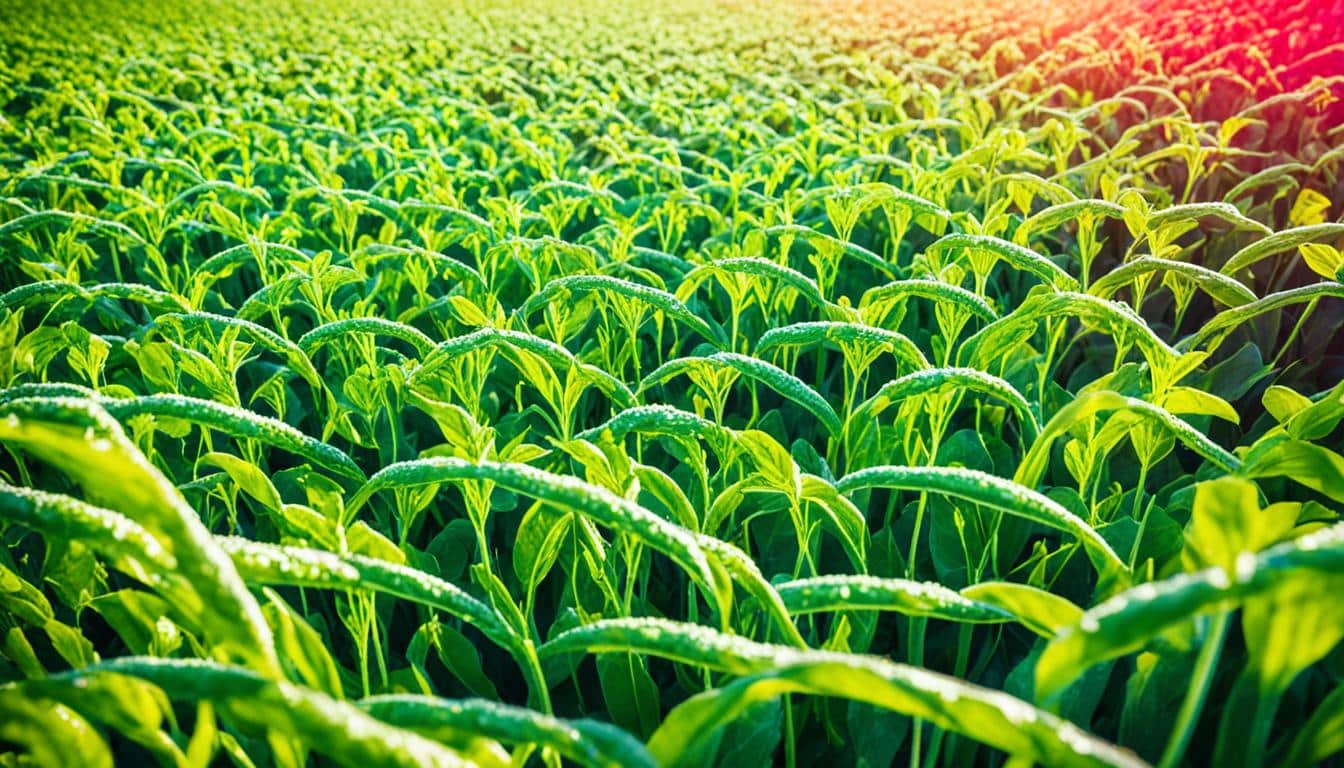
In 2012, a big chunk of U.S. plants were biotech ones. 88% corn, 94% cotton, and 93% soybeans were thanks to biotechnology. This shows how key biotechnology is in farming nowadays. It helps us meet food needs in a greener way, cuts costs, and boosts what farms produce.
Biotechnology does a lot for farming. It modifies products and makes helpful microorganisms. Genetic changes, for instance, let us make crops that fight off plant killers and bugs. This makes farming cheaper and better for the planet.
Take cotton that bugs don’t like, for example. By using this cotton, farmers need less chemical bug killers. It’s good for both the earth and how much we get from farms. Biotech is also looking into making our food more nutritious. It aims to add nutrients that fight diseases, and cut down things like allergies and unhealthy fats in food. So, this not only helps farmers sell more, but it also makes us healthier.
Agricultural biotechnology is a set of advanced tools. It changes living things to make agricultural products better. It’s grown a lot, especially in making crops that can fight off pests and survive weed killers. This is key in making farming more sustainable.
Agricultural biotechnology uses living things to make farming better. It uses things like genetic engineering and tissue cultures. These help plants grow more, fight off sickness, and deal with tough environmental conditions. They are a big part of making farming methods more innovative.
The use of biotechnology in farming started a long time ago with simple methods like picking the best plants to grow more. Fast forward to today, and we can change genes directly. In 2012, most of the United States’ corn, cotton, and soybeans were already altered in some way using biotechnology.
This wide use shows how important biotechnology is in farming. The USDA keeps track of how many biotech plants are grown in each state every year. The quick development of better crop types is thanks to new gene transfer methods. These push the limits of biotechnology’s role in sustainable farming.
The ISAAA has looked at biotech crops around the world. It shows how farming has moved from old ways to new ones that are better for the environment and economy. And these new ways cut down on costs too.
| Crop | Percentage of Biotech Plantings (2012) |
|---|---|
| Corn | 88% |
| Cotton | 94% |
| Soybeans | 93% |
These facts highlight how important and game-changing biotechnology is for farming. As we keep using genetic engineering and other tools, we’re making a bright future for farming. It focuses on being innovative and kind to our planet.
Genetic engineering has changed the game in farming by making key crops like corn, soybeans, and cotton much more productive. This technology has brought significant benefits in terms of crop yield and economic gain.
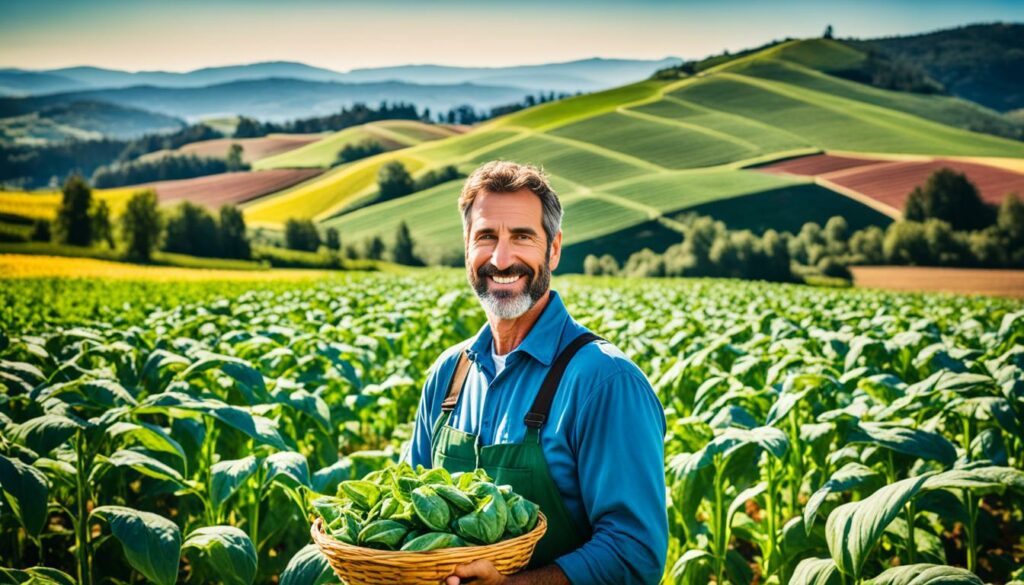
Biotech crops have been warmly welcomed in the U.S. By 2012, 88% of corn, 94% of cotton, and 93% of soybeans were genetically altered. These stats show how much we rely on genetic engineering for better crop outputs.
Insect-resistant cotton cut down on the need for harmful pesticides. Herbicide-tolerant soybeans and corn allowed for the use of less dangerous weed killers. These changes have led to increased profits and yields in major crops.
Biotech crops have not only bettered yields but also led to significant economic growth. Data from the USDA’s NASS states that they have upped yields by 22% and cut down on pesticides by 37%. Moreover, farmer profits have seen a hike of 68%, showing big economic and environmental wins.
A study of 147 research papers backs these results. It shows that insect-resistant crops bring more yield and less need for pesticides than herbicide-tolerant ones. This evidence proves the economic and practical value of biotech crops.
| Year | Corn | Soybeans | Cotton | Economic Gains (%) |
|---|---|---|---|---|
| 2012 | 88% | 93% | 94% | 68% |
| Pesticide Reduction | 37% | 37% | 37% | – |
| Yield Increase | 22% | 22% | 22% | – |
Genetic engineering is key to farming success and economic growth for farmers. It is crucial for the future of agriculture.
Biotechnology in agriculture is changing the game for sustainable farming. It helps make crops strong against tough conditions. This saves important resources like fuel, water, and feed. As a result, farming becomes more sustainable and productive.
In the United States, by 2012, biotech crops were in 88% of corn, 94% of cotton, and 93% of soybeans. This shows how widely they’re used and their success. They lead to better yields and help crops fight off pests and diseases.
Reducing the need for synthetic pesticides is a big win for biotech farming. Crops that tolerate herbicides make it easier to control weeds. This cuts down on the use of harmful chemicals. Also, making crops more nutritious, like adding beta-carotene to rice, fights malnutrition globally.
Biotechnology is also key in making antibiotics and new vaccines for animals. By doing so, it blends modern farming with saving the environment. This helps farming stay in balance with nature and reduces its carbon footprint.
Biotech’s work in farming extends to soil health and improving how nutrients move. Adding certain microorganisms to the soil boosts plant growth and quality. This method also fights off harmful plant diseases. Using natural resources for fertilisers and pesticides shows biotech’s vital part in eco-friendly farming.
Sustainable farming meets the world’s growing need for food and materials. It does this while keeping the environment safe and fair for all. Biotechnology plays a big role by making crops more resilient and nutritious. This ensures farming can be relied on for our food in the long run.
The benefits of genetic modification in farming go beyond just more crops. They also make major advancements in keeping pests away from plants. The big win is that less pesticides are needed.
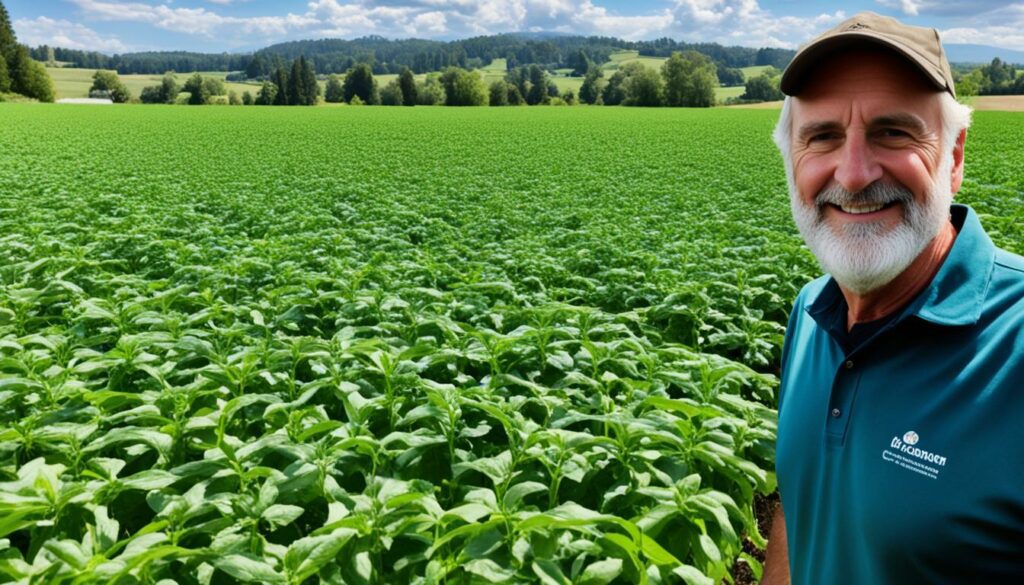
Some crops have been made to resist insects on their own. This has led to less need for man-made pest killers. In 2012, crops like these covered the majority of fields in the United States. This change has greatly cut down on how much pesticides harm our environment and water.
Keeping our planet safe is vital, and genetic farming changes have a key role to play. Some crops are now fine with less harmful weed killers. These help keep us and nature safe. They also mean farmers don’t have to dig up the soil as much. Not digging so much keeps the top layer in place and farming sustainable.
The US government and others really check these new crops to make sure they’re okay for us and the planet. The improvements in farming brought by these technologies are making a real difference. They are making pest control in farming good for the long-term health of the earth.
Biotechnology has changed how we farm. It offers many solutions that improve crops, making them strong and more productive. A great example is the Hawaiian papaya industry. It almost failed because of the Papaya Ringspot Virus. But, thanks to genetic engineering, we now have virus-resistant papayas. This saved the industry from collapse.
The Hawaiian papaya industry turned around with virus-resistant strains. This change shows a key benefit of biotechnology. It can defeat harmful plant diseases. By using genetic modification, not only did papaya farmers save their income, but they also kept a stable fruit supply for everyone to enjoy.
Biotech has helped make crops with great features. For instance, it made cooking oils healthier by cutting down on bad fats and things that cause allergies. There are also crops that grow well in salty earth or places with little water. This shows how far biotechnology can go in solving farming challenges.
In 2012, most corn, cotton, and soybeans in the U.S. were biotech crops. This shows how much farmers trust biotechnology. It helps control pests, weeds, and fights off diseases. Also, these crops often bring in more money because they yield better and are of higher quality.
Biotechnology is also good for the environment. We use fewer harmful chemicals on crops and help soil get better through phytoremediation. Government bodies like the USDA, EPA, and FDA make sure these crops are safe for us and wildlife.
The biotech field keeps growing. New ideas and efforts to make farming better and more sustainable are what drive it. This way, we can cut down costs of growing food and make sure there’s enough for everyone.
Biotechnology plays a big part in making soil healthier. It uses methods like phytoremediation. This means using special plants to clean soil by removing pollutants.
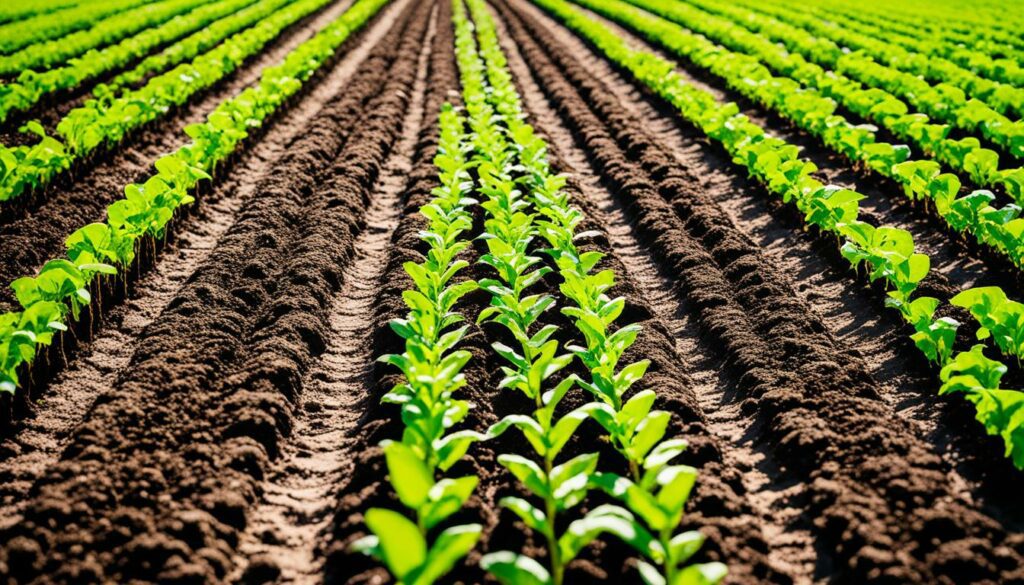
Phytoremediation is when certain plants clean the soil by taking in and getting rid of harmful substances. It helps make the soil cleaner. Using plants like modified poplar trees helps remove toxic metals and other pollutants.
This makes the soil better for growing crops. The process is good for the environment, helping plants and the ecosystem recover in the long run.
Besides making the soil cleaner, biotechnology also boosts the work of tiny organisms in the soil. These microorganisms help break down hard-to-digest materials and keep nutrients cycling.
Genetically modified plants give off helpful substances from their roots. These help good microbes grow. This in turn makes the soil richer and stronger. It also means the soil can keep growing crops well without getting ruined.
Government agencies like the USDA, EPA, and FDA watch over these advances in biotechnology. They make sure they’re safe for people and the earth. Their work ensures that making soil healthier using technology is both safe and good for everyone.
Biotechnology has brought clear economic benefits for farmers since 1996. These benefits include better crop quality and higher yields. Altogether, this has brought farmers a net benefit of $44.1 billion. In just 2007, farmers made $10.1 billion.
In the United States, most main crops like corn, cotton, and soybeans use biotechnology. By 2012, 88% of corn, 94% of cotton, and 93% of soybeans were biotech crops. This shows how much farmers gain in both quantity and quality. Farming becomes simpler and safer with these technologies.
The USDA, EPA, and FDA make sure biotech crops are safe for us and the environment. They set strict rules for testing. Using these crops means less synthetic pesticides, which is good for the planet and the economy.
| Year | Biotech Crop Plantings (%) | Net Economic Benefit ($ Billion) |
|---|---|---|
| 1996 | 60 | 2.5 |
| 2000 | 72 | 5.7 |
| 2007 | 85 | 10.1 |
| 2012 | 90 | 15.3 |
Biotech crops not only yield more, but they also fight off pests and weeds better. This resilience is crucial for economic growth in farming. These benefits go worldwide, with genetically engineered crops in 29 countries by 2019. An additional 42 countries import these crops. This brings better incomes for farms all over the world.
With the world’s population growing, we urgently need farming that is good for the environment. Biotech crops are a big help in this area. They reduce harm to our surroundings a lot.
Biotech crops cut down on the gases that harm our atmosphere. In 2016, GM crops lowered emissions like taking 16.7 million cars off the road. This drop is a big win against climate change, showing the key role of biotech crops.
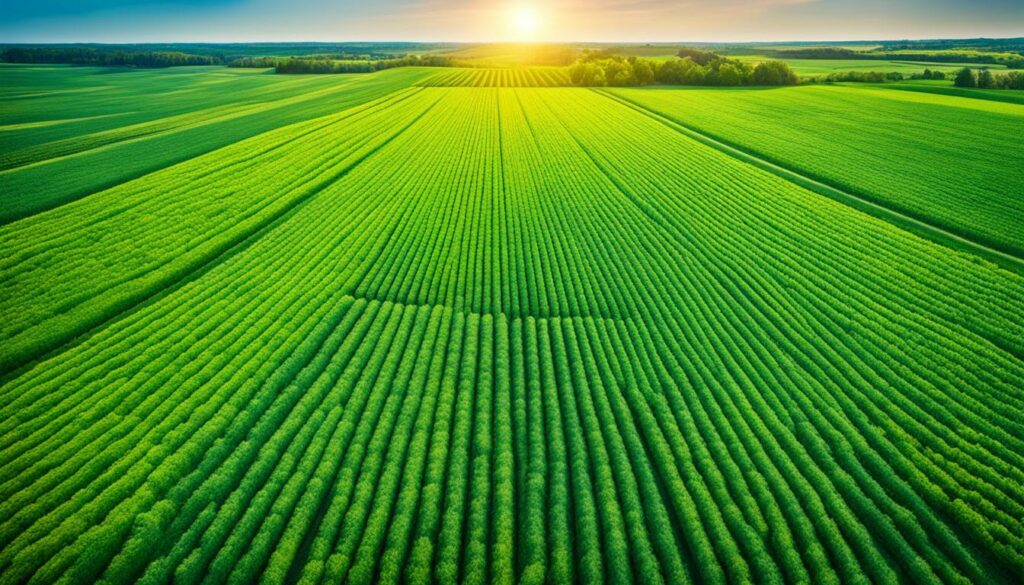
GM crops that resist bugs and need less weed killer have cut down on pesticides by 671.4 million kg worldwide. This is good news for our environment and makes our ecosystems healthier by using fewer chemicals.
Biotech crops encourage farming that is better for the earth. Crops that can tolerate weed killers make it possible to farm without ploughing the soil. This helps keep more soil alive, saves water, and stops soil from washing away. It also uses less fuel and keeps carbon dioxide out of the air.
| Metric | Impact |
|---|---|
| Reduction in Greenhouse Gas Emissions | Equivalent to removing 16.7 million cars annually |
| Pesticide Spraying Reduction | 671.4 million kg (8.2%) |
| Environmental Impact Reduction | 18.4% decrease in herbicide and insecticide use |
Using GM crops to farm less invasively, like in 2007, has the same effect as driving 6.3 million cars less for a year. This shows how important biotech is for making farming greener.
There’s a lot of research supporting the good that biotech crops do. Right now, 508 studies prove their benefits. This evidence shows how vital biotechnology is for farming’s future, ensuring it is both productive and kind to the planet.
Biotechnological advancements are changing crop nutrition, and this means better health and food security for everyone. One key method is biofortification, which boosts the nutrients in basic crops. For example, genetically altered rice made richer in beta-carotene fights vitamin A shortage in poorer areas.
These agricultural innovations are clearly seen in the US, with many farmers choosing biotech crops. By 2012, 88% of corn, 94% of cotton, and 93% of soybean crops there were biotech. The ISAAA also notes a wide acceptance of these crops globally, proving their importance in agriculture.
| Crop | Percentage of Biotech Plantings (2012) |
|---|---|
| Corn | 88% |
| Cotton | 94% |
| Soybean | 93% |
Moreover, genetic engineering has helped make crops more nutritious and sustainable. This includes rice with more beta-carotene and crops with improved oil. These steps support our food security and eco-friendly farming.
How people see biotechnology is key to its success. The changing world of biotechnology will affect how we make and handle food in the next ten years. People react differently to these changes. So, it’s vital to share the right information about biotechnology. This helps fight myths that stop us from using good, safe technologies.
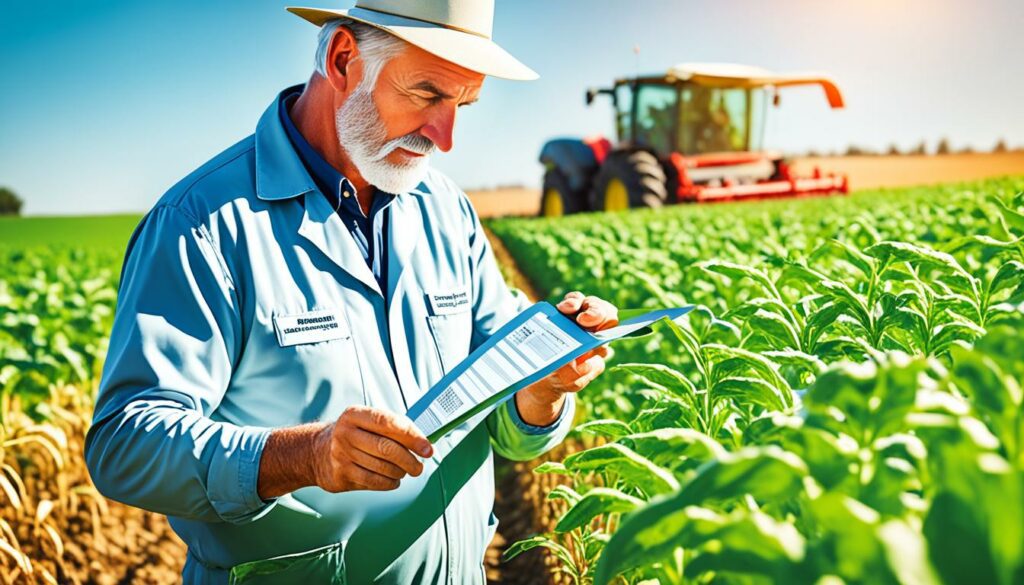
Teaching the public about biotechnology is crucial. When people understand it better, they are less scared of its risks. We should use trusted sources like TV, newspapers, and health groups to tell the truth. Getting the public involved in talks about biotechnology helps make good policies. For example, many people support plant biotechnology in Texas.
Clear talks about biotechnology myths are vital. They help match what people think with what science says. The public’s view on biotechnology is shaped by what they know, see as benefits, and if they trust rules. How much people like genetic engineering varies. In disease prevention, it’s well-received, but not as much for food crops. Talking openly between governments, businesses, and the public helps. This makes people more informed and supportive of biotech.
| Public Attitudes | Influencing Factors | Support Levels |
|---|---|---|
| General Sense of Uncertainty | Lack of Comprehensive Information | Varied across Different Applications |
| Trust in Information Sources | Perceived Biases in Information | High trust in TV, newspapers, medical profession |
| Acceptance of Biotechnology | Awareness of Benefits, Confidence in Agencies | Lower for food crops, higher for disease prevention |
Understanding how people see biotechnology is key. Addressing myths through clear, constant teaching can help. Talking openly with all involved is crucial for its successful use in farming.
The use of biotechnology in farming meets many challenges. Making farming tech that’s both useful and cheap is hard. It’s important the new tech works well with old farming ways and local plants. But, getting herbicide-tolerant crops to grow in Africa and South Asia is tough. They don’t adapt well to the local conditions.
Farming in the developing world is quite unique. In Africa, there are many different ways of farming. This makes using biotechnology a bit tricky. Plants like cassavas and yams are very important in these areas. But, they don’t get a lot of attention from biotech companies. Working with these crops might also reduce the need for manual work, affecting jobs, especially for rural women in countries with many workers.
Another big challenge is making biotech farming affordable. New tech and products should be priced right for everyone. High costs of special seeds make small farmers struggle. We need to find ways to make sure biotech products are not too pricey, so everyone can use them. In the U.S., for example, many farmers use biotech crops. But worldwide, their use is still pretty low.
China is a standout in using GM crops. By 2001, over 4 million Chinese farmers were growing GM cotton. Places like China and Mexico see big benefits from these crops. This is a bit different from developed countries, where the growth rate of using GM crops is slower.
In the 1990s, there were many biotech trials, but not many in developing countries. To solve the challenges, we need many different actions. This includes making better rules, talking with the communities, and keeping the environment safe. Doing all this can make biotechnology in farming more widely accepted. It can lead us to a better future in farming.
The future biotechnology prospects in farming look very promising. We have advanced tools like CRISPR to make crops better. They can face the issues of climate change and make more food for everyone. This is crucial for a growing world.

By 2012, most of the corn, cotton, and soybeans in the US were biotech. This shows biotechnology works and has big potential. It has improved rice with more beta-carotene and made oil plants better for you. It helps us fight against not getting enough nutrients.
The USDA, EPA, and FDA make sure modified crops are safe. They check that they won’t hurt people or the planet. It allows safe technology growth in farming.
The EU wants to be climate-friendly by 2050. Biotechnology is key for eco-friendly farming. It cuts down on harmful pesticides and boosts farm efficiency.
As the world’s population grows, we need more smart farming. There won’t be much new land by 2050. So, these new crops from biotech are super important. They keep the soil healthy and support sustainable farming. This is critical for our future.
Many people don’t get enough iron from their food, especially women. Biotechnology can help by making crops richer in nutrients. This is another big win for global health.
In the end, biotechnology is changing farming for the better. It helps us now and gets us ready for what’s next. Our future in farming is strong, thanks to these new developments.
Today, biotechnology plays a big role in farming by supporting sustainable practices. These aim to work well with nature. They help keep the soil, environment, and ecosystems healthy.
In the last few years, biotechnological boosts have really improved farm output. This has been through better ways to manage fields, develop plants, and make fertilisers. Crops like maize, rice, wheat, and soybean have seen their yearly output go up by small percentages. But, with more people to feed, we need these numbers to grow faster.
Let’s compare the usual ways of farming with the sustainable ones:
| Aspect | Conventional Agriculture | Sustainable Agriculture |
|---|---|---|
| Focus | Yield Maximisation and Financial Gain | Eco-friendly, Productive, Economically Viable, and Socially Equitable |
| Approach | Advanced Technologies and Synthetic Inputs | Balanced Ecological Approach emphasizing Soil Health and Biodiversity |
In 2012, most biotech plantings in the U.S. were corn, cotton, and soybeans. This technology has cut down on using lots of pesticides. It’s also made it possible to use weed killers that are safer for the earth. This helps the soil and the plants that grow in it.
Using biotechnology is a key part of making farming sustainable. It is essential to meet the food needs of the future. Genetically modified crops like virus-resistant papayas have been a real success story in the U.S. They show the clear benefits of biotechnology. It helps create farms that are both productive and in line with protecting the environment.
Biotechnology is key in tackling climate change effects. It helps create crops resistant to drought and able to grow in salty soil. This work is vital in ensuring our food supply remains steady in tough times.
Scientists use biotechnology to make crops that can survive without much water. These crops are a big help to the 1.5 to 2.0 billion people hit by water stress. For instance, drought-tolerant corn is now grown in dry areas of the U.S. And, places like Argentina and Brazil use wheat that can withstand droughts. Thanks to genetic changes, we’ve seen better pest control and more food since 1996. Biotech innovators in China, Brazil, and India are pushing these gains even further.
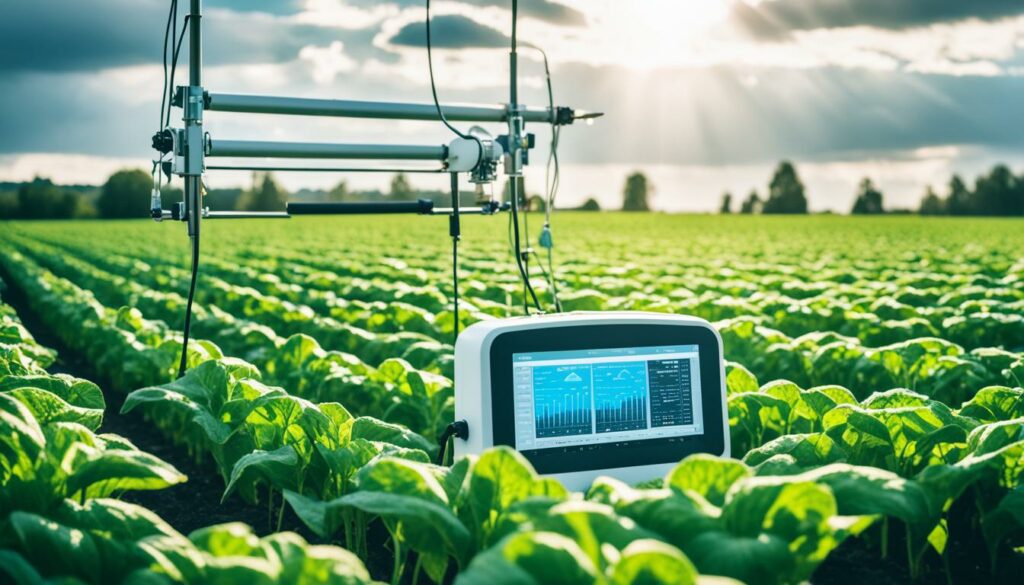
Biotechnology is also finding ways to help plants grow in salty soil. With about a fifth of the world’s farm lands too salty for most crops, this is crucial. One example is a gene called HRD in special rice. It makes the rice use water better, which helps it grow more efficiently. These advances allow farming in places that were not good for crops before. So, farming can stay strong even as soil salt levels keep rising.
In short, biotechnology has brought many advantages to farming. Over 60-70 percent of food you find in US shops has genetically engineered plants. This shows how important these new methods are. Almost a third of US corn and about three-quarters of soybeans and cotton are from biotech. They help more than you might think. For example, “Bt” corn and soybeans that resist weed killer have really helped farmers. These kinds of crops make farming easier and more successful.
One big win is making papayas safe from a destructive virus. This saved the papaya industry from collapsing. Also, making cheese using bacteria that were changed by scientists is a success. It makes the cheese-making process better and cheaper. And, creating new animal vaccines is another wonderful use. They protect animals from serious illnesses, thanks to biotechnology.
But, we must be careful about the future of biotech in farming. Yes, it brings some good things. For instance, it can lower how much pesticide farmers need. It also makes crops tougher against bad weather. But, there are also new problems to think about. So, people need to think very carefully about the safety of using biotech in farming. The FAO checks each new biotech product to make sure it’s safe. This kind of careful review is the best way to move forward.
Biotechnology boosts crop yields and quality. It makes plants tougher, helping them fight pests and weeds. This reduces costs and lessens harm to the environment.
It lessens the need for resources by making crops hardy. This includes needing less water and chemicals. It also helps protect wild areas. This is by reducing the use of harmful pesticides.
Genetic engineering is about making crops better. They can resist pests and weed killers. This makes farming easier and more efficient. Farmers can grow more and save money.
In the U.S., corn, soybeans, and cotton are great examples. They yield more and fight off pests well. This brings in more money for farmers.
In Hawaii, farmers grow virus-resistant papayas. There are also healthier cooking oils and foods that cause fewer allergies. Plus, there are plants that can grow in dry, salty soils.
It cleans soil from harmful substances. This is through plants that have been changed to do this. It also makes soil richer by helping nutrients move around better.
Farmers earn more as they produce higher-quality food. They also spend less on growing it. This adds up to a lot of extra money for them worldwide.
Growing crops with biotech methods cuts down on turning the soil. This saves fuel and lowers gas emissions. It’s like taking many cars off the road each year.
Biotechnology has made crops more nutritious. For example, rice now has more vitamins to fight hunger and improve health worldwide.
We must share more facts about biotechnology’s good sides. This means showing its benefits and safety. It’s also about clearing up any wrong ideas people might have.
People might be worried about it, and there are rules to follow. Making sure everyone can use these new ways fairly is important. We also have to keep nature safe.
The future looks bright. We can use new tools like CRISPR to make crops better. This will help food grow even in tough conditions.
It helps farms become more friendly to the earth. This means they produce more food but with less harm to nature. It’s about farming in smart, safe ways.
It lets us make crops that can handle hard conditions. These include not having much water or salty ground. This makes farming more ready for changes in the world’s climate.